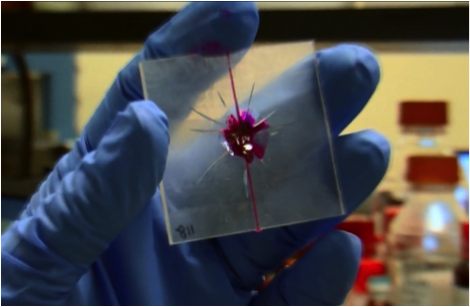VIDEO-Self-Healing Plastics Make a Major Breakthrough > ENGINEERING.com
 In today’s world of ubiquitous products one thing has always been missing: materials that can take a beating and still perform at their peak.
In today’s world of ubiquitous products one thing has always been missing: materials that can take a beating and still perform at their peak.While the age of shattered iPhones, remotes and car bumpers is still very much upon us, researchers at the University of Illinois may have made a breakthrough that could make self-healing plastics a reality sooner than ever imagined.
Even though self-healing materials have been around for centuries, they’ve really only been able to stitch up small cracks and fractures in a compromised material. However, if U. Illinois researchers have anything to say about it new materials may be able to repair even large holes in a material due to a biologically-inspired vascular nature.
“We have demonstrated repair of a nonliving, synthetic materials system in a way that is reminiscent of repair-by-regrowth as seen in some living systems,” said Professor of Chemistry Jeffery Moore.
To achieve this repair by regrowth phenomenon the new material contains “specially formulated fibers” that act as capillaries, branching through the body of their host polymer. Composed of two separate lines that run parallel to one another, each capillary is equipped with two “regenerative materials” that are mixed when their host is damaged. Once mixed, the binary regenerative cocktail forms a gel that crawls over itself, hardening into a polymer with mechanical properties identical to its original.
“For the first time, we’ve shown that you can regenerate lost material in a structural polymer. That’s the kicker here,” said Scott White, lead researcher on the project. “Prior to this work, if you cut off a piece of material, it’s gone. Now we’ve shown that the material can actually regrow.”
Researchers state that their synthetic material can begin to form a gel and harden immediately, ensuring that damage is repaired efficiently without wasting any healing material. Furthermore, if a material is punctured to the point where it needs more material than was contained within its capillary network more material can be pumped in, coagulating once it reaches its destination.
Imagine returning home after a daredevil adventure and plugging a favorite but damaged device into a system that could pump that device full of chems and return it to pristine condition. Even better, imagine if buildings damaged by natural or man-made disasters could be repaired in a similar manner.
Though that reality seems a bit fanciful, it might be how the Illinois team’s research manifests. If that does come to fruition, today’s methods of manufacturing and warranties may become obsolete as buyers begin to purchase repair materials (rather than new machines) when a device is damaged.
Image and Video Courtesy ofBeckman Institute